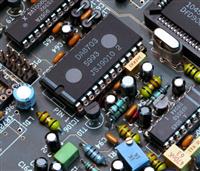
Aluminum PCB- Ideal Solution For Heat Dissipation Requirement
PCB is the core of modern electronics. It is used in all kinds of equipment, from small IoT devices medical devices, industrial robots, automobiles, and aircraft. To ensure your project work as intended, it is important to select the right substrate for the PCBs. As one of the popular metal-core PCBs, Aluminum PCBs have been widely used in electronic devices for their excellent Heat dissipation. In this article, we will discuss the Aluminum PCB in detail regarding its structure, characteristics, and applications.
What is Aluminum PCB
Aluminum PCBs are aluminum-based copper-clad laminate that consists of a circuit layer (copper foil), a dielectric layer, and an aluminum substrate.
Figure 1: Structure of an Aluminum PCB
Circuit layer
The circuit layer (generally electrolytic copper foil) is etched to form a printed circuit for assembly and connection of devices. Compared with the traditional FR-4 with the same thickness and the same line width, the aluminum PCB can carry a higher current.
Based on the copper foil thickness, the common types of Aluminum PCB includes 12um,15um,18um,25um,35um,70um, etc.
Dielectric layer
The dielectric layer serves the functions of bonding, insulation, and heat conduction. The better the thermal conductivity of the dielectric layer, the better its heat dissipation performance. Thus, the more efficient it would be to lower the device's operating temperature.
The standard thickness of the dielectric layer is 0.05-0.2mm. A thicker dielectric layer has a better insulation effect and voltage resistance performance. While a thinner dielectric layer performs well in heat dissipation but is easy to encounter short circuits. According to the thermal conductivity and withstand voltage value, the dielectric layer can be divided into the following types.
|
Types of the dielectric layer |
|||
|
Thermal conductivity |
Low (1W and below) |
Middle (1.5W, 2W) |
High(3W and above) |
|
Withstand voltage value |
Low (AC 800V) |
Standard (AC 1500V) |
High (AC over 2000V) |
Aluminum substrate
Aluminum as the base layer is an ideal option for metal-core PCBs considering its thermal expansion coefficient, thermal conductivity, strength, hardness, and also cost. The commonly used aluminum material includes pure aluminum, magnesium-aluminum alloy, and magnesium-Si-Al alloy.
Figure 2: Aluminum PCB from PCBGOGO
Characteristics of aluminum PCB
Heat dissipation
Aluminum PCB is famous for its excellent heat dissipation characteristics. With the same thickness of 1.5mm, Aluminum PCB has a thermal resistance of 20~22 ℃ while the FR-4 PCB is only 1.0~2.0 ℃. Compared with standard FR-4 PCB, the aluminum PCB can reduce the thermal resistance to a minimum, that’s why it has excellent thermal conductivity. In an aluminum PCB, the components are surface mounting on the circuit layer. When a device is operating, the heat generated is quickly conducted to the aluminum base layer through the insulating layer, and then transferred out by the aluminum layer thereby realizing the heat dissipation of the device. It can reduce the operating temperature of the project, prolong the service life, and improve power density and reliability.
Thermal expansion coefficient
The high temperature will lead to changes in the thickness and flatness of the circuit board, especially the thermal expansion in the thickness side, which affects the quality of metalized holes and circuits. The main reason for this is the different thermal expansion coefficient between the copper-clad laminate and the substrate materials. The thermal expansion coefficient of copper is 17×106cm/cm°C while the FR-4 substrate is 110×106cm/cm°C. With such a difference it is easy to encounter thermal expansion effects. However, for aluminum substrate, the coefficient is 50×106cm/cm°C, closer to that of the copper foil, which ensures the quality and reliability of the PCB in a high-temperature environment. Thanks to this feature, it helps to decrease the effect associated with thermal expansion and contraction problems of the components and also facilitates the SMT assembly process.
Figure 3: Aluminum PCB from PCBGOGO
Dimensional stability
The size of the aluminum substrate is more stable than other circuit boards with different insulating materials. Its size change is only 2.5%-3% when heated from 30℃ to 140℃-150 ℃.
Applications of Aluminum PCB
1. Audio equipment: input, output amplifiers, balanced amplifiers, audio amplifiers, preamplifiers, power amplifiers, etc.
2. Power supply equipment: switching regulator, DC/AC converter, SW regulator, etc.
3. Communication electronic equipment: high-frequency amplifier, filter electrical appliance, sending circuit.
4. Office automation equipment: motor drives, etc.
5. Automobile: electronic regulator, igniter, power controller, etc.
6. Computer: CPU board, floppy disk drive, power supply unit, etc.
7. Power module: inverter, solid-state relay, rectifier bridge, etc.
8. Lighting: LED lighting products, fluorescent tubes, meteor lights, car lights
Figure 4: LED Aluminum PCB
Conclusion
The Aluminium PCB is widely used for applications that require heat dissipation. Lightweight itself, aluminum PCB helps to reduce product size and save assembly costs without needing additional heat sinks. If thermal dissipation is a key factor in your PCB design, Aluminum PCB would be your ideal option. PCBGOGO is good at manufacturing Aluminum PCB from single layer to 4 layers. Contact them and get a quote today!







